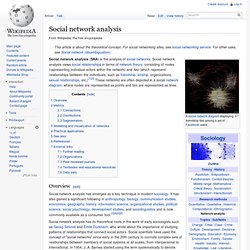

Social network analysis. Social network analysis (SNA) is the analysis of social networks.

Social network analysis views social relationships in terms of network theory, consisting of nodes (representing individual actors within the network) and ties (which represent relationships between the individuals, such as friendship, kinship, organizations, sexual relationships, etc.)[1][2] These networks are often depicted in a social network diagram, where nodes are represented as points and ties are represented as lines. Overview[edit] Social network analysis has emerged as a key technique in modern sociology.
It has also gained a significant following in anthropology, biology, communication studies, economics, geography, history, information science, organizational studies, political science, social psychology, development studies, and sociolinguistics and is now commonly available as a consumer tool.[3][4][5][6] Epistemologija. Epistemologija je izraz, ki se uporablja v dveh različnih, a sorodnih pomenih. 1.

V anglosaških deželah jo razumejo kot spoznavno teorijo (gnoseologijo) - gre za vprašanja, ki zadevajo človeško spoznanje nasploh (npr. znamenito Kantovo vprašanje: Kaj lahko vem? - se pravi: Kaj lahko katerikoli človek ve?) 2. Drug pomen srečamo v frankofonskih deželah: tam pomeni raziskovanje znanstvenih spoznanj in načinov, kako se producira znanstveno znanje ter kako znanost opisuje svet. Dihotomija izvira iz razumevanja grške besede ἐπιστήμη (epistēmē): lahko jo razumemo kot znanje ali kot znanost. Zaradi dominantosti ameriške kulture in angleškega jezika se prvi pomen (tj. spoznavna teorija) uveljavlja tudi v drugih kulturah (in jezikih). Taksonomija. Izvorno se je izraz taksonomija nanašal na klasifikacijo živih organizmov (sedaj znana kot alfa taksonomija); dandanes pa izraz zajema veliko bolj široko in splošno področje in se nanaša na klasifikacijo stvari, poleg tega pa tudi na načela, ki so osnova tovrstne klasifikacije.

Skoraj vse – žive stvari, nežive stvari, prostori, koncepti, dogodki, lastnosti in razmerja – lahko razvrstimo po neki taksonomski shemi. Kategorije Wikipedie ilustrirajo taksonomsko shemo. Zelo pomembni podvrsti taksonomije v biologiji sta znanstvena razvrstitev in biološka sistematika. V geografiji lahko na primer govorimo o geomorfologiji kot o taksonomiji kopenskih oblik. Izraz taksonomija se lahko nanaša tudi na sheme odnosov, ki niso v hierarhiji starš-otrok, kot so mrežne strukture z drugimi tipi odnosov. Taksonomija je lahko tudi preprosta organizacija stvari v skupine ali celo abecedni seznam.
Matematično, je hierarhična taksonomija drevesna struktura klasifikacije za dani niz objektov. Ontologija. Theory and History of Ontology.

Knowledge management. Knowledge management (KM) is the process of capturing, developing, sharing, and effectively using organizational knowledge.[1] It refers to a multi-disciplined approach to achieving organisational objectives by making the best use of knowledge.[2] An established discipline since 1991 (see Nonaka 1991), KM includes courses taught in the fields of business administration, information systems, management, and library and information sciences.[3][4] More recently, other fields have started contributing to KM research; these include information and media, computer science, public health, and public policy.[5] Columbia University and Kent State University offer dedicated Master of Science degrees in Knowledge Management.[6][7][8] History[edit] In 1999, the term personal knowledge management was introduced; it refers to the management of knowledge at the individual level.[14] Research[edit] Dimensions[edit] The Knowledge Spiral as described by Nonaka & Takeuchi.

Pearltree - wikipedia. Pearltrees refers to itself as "a place for your interests".[8] Functionally the product is a visual and collaborative curation tool[9][10][11][12] that allows users to organize, explore and share any URL they find online as well as to upload personal photos, files and notes.[13] The product features a unique visual interface[14][15] that allows users to drag and organize collected URLs, and other digital objects.[16] that themselves can be further organized into collections and sub-collections,[17] (URLs).

Users of the product can also engage in social/collaborative curation using a feature called Pearltrees Teams.[18] Pearltrees was founded by Patrice Lamothe, CEO,[22] Alain Cohen, CTO,[23] Nicolas Cynober, Technical Director,[24] Samuel Tissier, Ergonomy/UI[25] and Francois Rocaboy, CMO.[26] History[edit] Development of Pearltrees began in 2007. In July 2012 Pearltrees launched their iPhone app. Pearltrees introduced Pearltrees 2.0 on May 22nd, 2014.